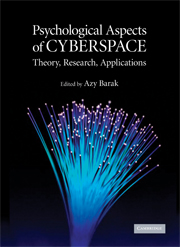Book contents
- Frontmatter
- Contents
- List of Tables
- List of Figures
- Preface
- List of Contributors
- 1 Reflections on the Psychology and Social Science of Cyberspace
- 2 Privacy, Trust, and Disclosure Online
- 3 Internet Abuse: Emerging Trends and Lingering Questions
- 4 Flow Experience in Cyberspace: Current Studies and Perspectives
- 5 Cybertherapeutic Theory and Techniques
- 6 Exposure in Cyberspace as Means of Enhancing Psychological Assessment
- 7 Down the Rabbit Hole: The Role of Place in the Initiation and Development of Online Relationships
- 8 The Sexy Side of the Internet: An Examination of Sexual Activities and Materials in Cyberspace
- 9 The Contact Hypothesis Reconsidered: Interacting via Internet: Theoretical and Practical Aspects
- 10 Influences on the Nature and Functioning of Online Groups
- 11 Online Motivational Factors: Incentives for Participation and Contribution in Wikipedia
- 12 How Internet-Mediated Research Changes Science
- Index
- References
7 - Down the Rabbit Hole: The Role of Place in the Initiation and Development of Online Relationships
Published online by Cambridge University Press: 05 June 2012
- Frontmatter
- Contents
- List of Tables
- List of Figures
- Preface
- List of Contributors
- 1 Reflections on the Psychology and Social Science of Cyberspace
- 2 Privacy, Trust, and Disclosure Online
- 3 Internet Abuse: Emerging Trends and Lingering Questions
- 4 Flow Experience in Cyberspace: Current Studies and Perspectives
- 5 Cybertherapeutic Theory and Techniques
- 6 Exposure in Cyberspace as Means of Enhancing Psychological Assessment
- 7 Down the Rabbit Hole: The Role of Place in the Initiation and Development of Online Relationships
- 8 The Sexy Side of the Internet: An Examination of Sexual Activities and Materials in Cyberspace
- 9 The Contact Hypothesis Reconsidered: Interacting via Internet: Theoretical and Practical Aspects
- 10 Influences on the Nature and Functioning of Online Groups
- 11 Online Motivational Factors: Incentives for Participation and Contribution in Wikipedia
- 12 How Internet-Mediated Research Changes Science
- Index
- References
Summary
When Lewis Carroll's Alice falls down the hole into Wonderland, she encounters a variety of situations in various places: a garden, a forest, a pool, a kitchen, a castle, and a courtroom, among others. The characters she meets who become her acquaintances, friends, and enemies differ depending on her location in her travels, and, of course, her size. She follows the White Rabbit who is terrified of her larger-than-human height in the hallway. She learns to adjust her size to match the places, objects, animals, and people who cross her pathways. People have likened “cyberspace” to the world found through the mirror, the virtual reality on the other side contrasted to the everyday physical world.
As the experience of people online accumulated, researchers differentiated modes of relating within cyberspace such as the use of the asynchronous and the synchronous or real-time media. They have begun to illuminate differences in the types of spaces, places, or settings online (see Baker, 2002, 2005; Baker & Whitty, 2008; McKenna, 2007; Whitty & Carr, 2006). A current line of inquiry attempts to explicate interactions that originate but do not remain in cyberspace, or relationships that span online and offline places. Researchers of online relationships recognize that people online often “felt as though they have gotten to know each other quite well” (Walther & Parks, 2002, p. 549) before meeting offline (Baker, 1998), entering “mixed mode relationships” (Walther & Parks, 2002, p. 542).
- Type
- Chapter
- Information
- Psychological Aspects of CyberspaceTheory, Research, Applications, pp. 163 - 184Publisher: Cambridge University PressPrint publication year: 2008
References
- 8
- Cited by



